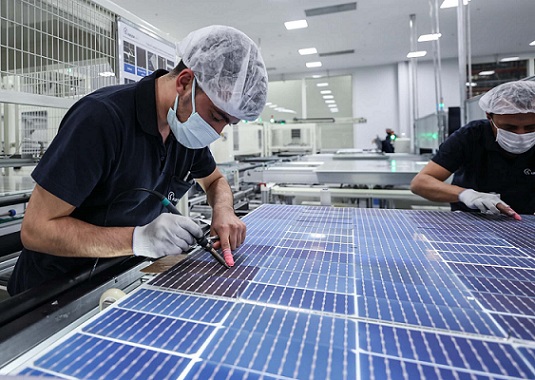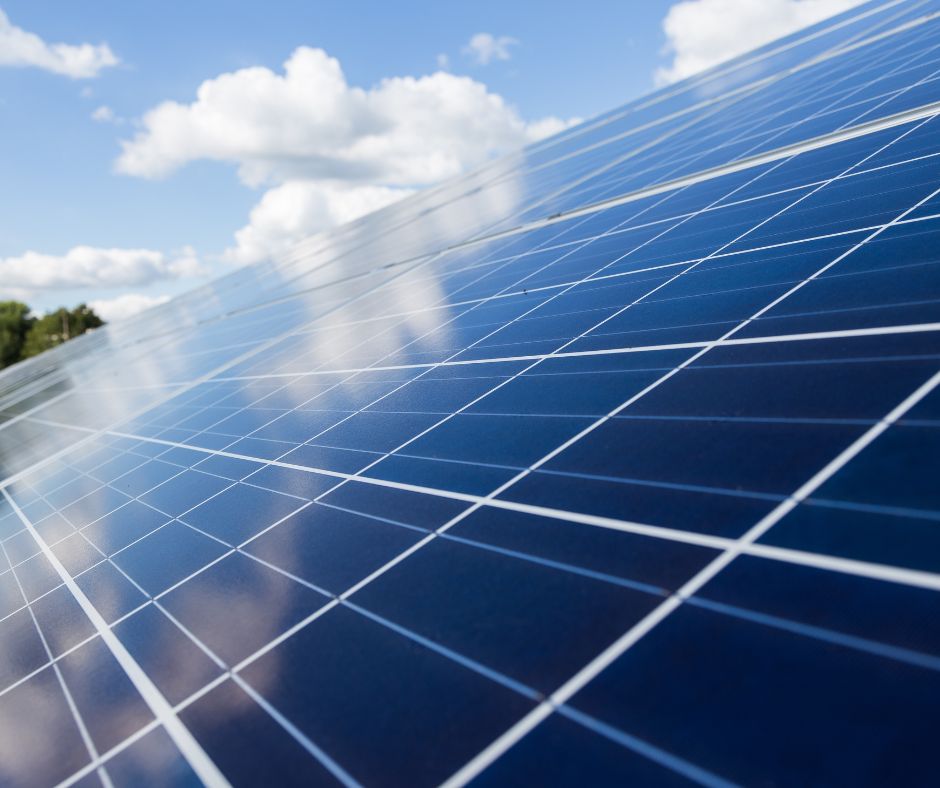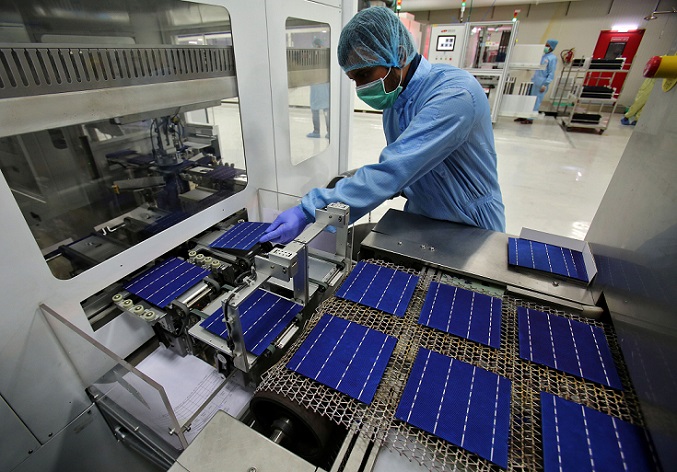Solar panels are devices that convert sunlight into usable AC electricity through inverters. The use of solar power has gained popularity over the years as a clean, renewable energy alternative to fossil fuels. The Solar Energy Industries Association reports that the installed solar energy is sufficient to provide power for 13.1 million households. But, how are solar panels made? What are the key components and the manufacturing process involved?
In this article, we will unravel the mystery behind solar panel manufacturing.
Where are solar panels made?

Solar panels are manufactured all over the world, with China being the largest producer of solar panels. Other major players in the solar manufacturing industry include the United States, Germany, and Japan.
What are solar panels made of?
Solar materials vary depending on the type of panel, but most solar panels are made up of silicon cells. Silicon is a raw material that is abundantly available and commonly used in PV cell technology. Other materials used in solar panels include ethylene vinyl acetate (EVA), metal connectors, and an aluminum frame.
What types of solar panels made are there?

Three primary categories of solar panels exist, which include monocrystalline panels, polycrystalline panels, and thin film panels.
Monocrystalline Solar panels
Monocrystalline panels, highly efficient in nature, are manufactured using a solitary silicon crystal.
Polycrystalline panels
Polycrystalline panels are made up of several silicon crystals and are less expensive than monocrystalline panels.
Thin Film Panels
Thin film panels are made by depositing a thin layer of photovoltaic material onto a substrate and are the least expensive of the three types.
Solar Panel Manufacturing Process

The manufacturing process of solar panels involves several steps that begin with raw materials and end with the finished solar module.
A. Raw Materials
1. Silicon
The first step in the manufacturing process involves obtaining raw silicon. Metallurgical grade silicon, which contains impurities such as carbon, is purified to produce pure silicon. The pure silicon is then heated to a very high temperature, and as it cools, it forms purified silicon cylinders.
2. Ethylene Vinyl Acetate (EVA)
EVA is a plastic that is used to laminate photovoltaic cells and protect them from the elements.
3. Metal Connectors
Metal connectors are used to join the solar cells and form the solar panel.
B. Silicon Processing
Melting and Purification
The purified silicon cylinders are melted at a very high temperature and then purified further to remove any remaining impurities.
Cylindrical Ingot Formation
The purified silicon is then allowed to cool and solidify into a cylindrical ingot.
Silicon Wafer Production
The cylindrical ingot is sliced into thin sheets, called silicon wafers, which are used to make solar cells.
C. Solar Cell Technology and Manufacturing
Doping
The silicon wafers are doped with impurities to create a negative and positive electrical orientation. This is done to create a p-n junction that allows the solar cell to conduct electricity.
Electrical Contacts
The manufacturer adds electrical contacts to the PV cell to allow the flow of electrons and the generation of electrical current.
Anti-Reflective Coating
The manufacturers apply an anti-reflective coating to the PV cell, which reduces the amount of light reflected away from the cell and increases its efficiency.
D. Solar Panel Production
Solder Solar Cells: Manufacturers solder the solar cells together and connect them with metal connectors to form a grid-like matrix.
Encapsulation: To protect the solar cells from the elements, manufacturers encapsulate them in a layer of EVA.
Aluminum Metal Frame: The solar panel receives an aluminum metal frame to provide support, and protection, and increase its solar capacity.
Key Components of a Solar Panel System

Several key components work together to produce electricity from the sun’s energy, making up a solar panel. These components include solar cells, solar materials, and solar modules.
A. Solar Cells
Solar cells are the heart of a solar panel, and they are responsible for converting sunlight into electricity. There are two main types of PV cells: monocrystalline cells and thin-film cells. Manufacturers make monocrystalline cells from a single crystal of silicon, which provides them with a high level of efficiency and a uniform appearance. They make thin-film cells by depositing a thin layer of photovoltaic material onto a substrate. While they are less efficient than monocrystalline cells, they are more flexible and less expensive to produce.
B. Solar Panel Materials
Solar panel manufacturers use several different materials, including crystalline silicon, amorphous silicon, and other thin-film materials, to make solar panels. Manufacturers slice the ingots into thin wafers and use them to make PV cells. They slice the ingots into thin wafers and use them to make PV cells.
Thin-film solar panels use amorphous silicon as another type of material. Manufacturers deposit a non-crystalline form of silicon, called amorphous silicon, onto a substrate using a process called plasma-enhanced chemical vapor deposition (PECVD). Manufacturers can use cadmium telluride, copper indium gallium selenide, and organic photovoltaic materials as other thin-film materials to make solar panels.
C. Solar Modules
Manufacturers connect thin layers of photovoltaic cells in a grid-like matrix to create solar modules. They also use metal connectors to connect the cells, and then encapsulate the module in a protective layer of ethylene vinyl acetate (EVA). Manufacturers frame the entire module in an aluminum frame to protect it from the elements.
How Solar Panels Work

Solar panels work by using the photovoltaic effect to convert light into electricity. The photovoltaic effect is the process by which solar panels convert sunlight into electricity. When sunlight hits a photovoltaic panel, it causes electrons in the solar cells to begin moving, which generates an electrical current.
Furthermore, the electrical current generated by a photovoltaic panel is DC (direct current) electricity, which is not usable by most household appliances. An inverter converts the electricity to AC (alternating current) electricity, making it usable. Users can then use the AC electricity to power appliances, or feed it back into the electrical grid.
Testing the Quality of Newly Manufactured Solar Panels

Testers conduct quality assurance testing on the panels after the solar manufacturing process is complete. This testing process ensures that the panels meet the technical specification sheet and are free of any defects. The testing process includes visual inspection, electrical testing, and performance testing so they are ready to install.
Visual Inspection: Inspectors visually examine the solar panels for any visible defects, such as cracks, chips, or blemishes.
Electrical Testing: Electrical testing measures the output of the photovoltaic cell panel to ensure that it matches the technical specification sheet. It also checks for any short circuits or open circuits.
Performance Testing: To measure the energy output of the solar panel, testers conduct performance testing. Testers subject the photovoltaic cell panel to varying weather conditions, including bright sunlight, partial sunlight, and cloudy weather during testing.
Finally, if the solar panels pass all three tests, they are then ready for shipment to the customer.
How Much Does Raw Silicon Cost?
![]()
Producers primarily use silicon as the main raw material in the production of solar panels. The cost of raw silicon can vary depending on the market demand and supply. In recent years, the cost of silicon has decreased, making solar panels more affordable.
Furthermore, the cost of raw silicon can range from $10 to $15 per kilogram. However, the cost of silicon accounts for only a small fraction of the total cost of producing solar panels.
Silicon Production and Mining Facts
![]()
Many minerals, including quartz, feldspar, and mica, contain silicon, which is the second most abundant element on Earth. The most common method of producing silicon is through the reduction of silicon dioxide (SiO2) with carbon at very high temperatures, which produces carbon dioxide (CO2) as a byproduct.
In conclusion, Silicon mining and production can have environmental impacts. The mining process can cause deforestation, soil erosion, and air and water pollution. However, the solar industry has been working to reduce its impact on the environment by using sustainable production methods and developing recycling programs for end-of-life solar panels.
Frequently Asked Questions
Does Canada make solar panels?
Yes, Canada has several companies that manufacture solar panels, including Canadian Solar, Heliene, and Silfab Solar. As a result, these companies produce both crystalline silicon solar panels and thin-film solar panels.
Does Canada produce silicon?
Yes, Canada does produce silicon. The country has several companies that produce silicon, including Dow Corning, Ferro Silicon Quebec, and Timminco. These companies produce silicon for various applications, including the production of solar panels, electronics, and construction materials.
Where does silicon come from in Canada?
Canadian producers primarily produce silicon from quartz, a common mineral found in the Canadian Shield and other geological formations. The production of silicon involves several processes, including mining, crushing, and refining the quartz into pure silicon. Several silicon production facilities are located in Quebec and Ontario, where Canadian producers concentrate their silicon production.


Leave a Reply